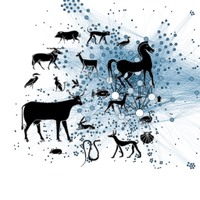Microbial colonization of tannin-rich tropical plants: interplay between degradability, methane production and tannin disappearance in the rumen
This article has been Reviewed by the following groups
Discuss this preprint
Start a discussion What are Sciety discussions?Listed in
- Evaluated articles (Peer Community in Animal Science)
Abstract
Condensed tannins in plants are found free and attached to protein and fibre but it is not known whether these fractions influence rumen degradation and microbial colonization. This study explored the rumen degradation of tropical tannins-rich plants and the relationship between condensed tannins fractions’ disappearance and microbial communities colonising plant particles. Leaves from Calliandra calothyrsus, Gliricidia sepium , and Leucaena leucocephala , pods from Acacia nilotica and the leaves of two agricultural by-products: Manihot esculenta and Musa spp. were incubated in situ in the rumen of dairy cows. An in vitro approach was also used to assess the effects of these plants on rumen fermentation parameters. All plants contained more than 100 g/kg of condensed tannins with a large proportion (32 to 61%) bound to proteins. Calliandra calothyrsus had the highest concentration of condensed tannins at 361 g/kg, whereas Acacia nilotica was particularly rich in hydrolysable tannins (350 g/kg). Hydrolysable and free condensed tannins from all plants completely disappeared after 24 h incubation in the rumen. Disappearance of protein-bound condensed tannins was variable with values ranging from 93% for Gliricidia sepium to 21% for Acacia nilotica . In contrast, fibre-bound condensed tannins disappearance averaged ~82% and did not vary between plants. Disappearance of bound fractions of condensed tannins was not associated with degradability of plant fractions. The presence of tannins interfered with the microbial colonisation of plants. Each plant had distinct bacterial and archaeal communities after 3 and 12 h of incubation in the rumen and distinct protozoal communities at 3 h. Adherent communities in tannin-rich plants had a lower relative abundance of fibrolytic microbes, notably Fibrobacter spp. Whereas, archaea diversity was reduced in high tannin-containing Calliandra calothyrsus and Acacia nilotica at 12 h of incubation. Concurrently, in vitro methane production was lower for Calliandra calothyrsus, Acacia nilotica and Leucaena leucocephala although for the latter total volatile fatty acids production was not affected and was similar to control. Here we show that the total amount of hydrolysable and condensed tannins contained in a plant govern the interaction with rumen microbes affecting degradability and fermentation. The effect of protein- and fibre-bound condensed tannins on degradability is less important.


